Wine rating

100 people, 100 tastes, or how to objectively assess and evaluate wine
The system of scoring and evaluating wines in the world is really diverse and very interesting. Thinking about how to objectively evaluate a wine, or where the line between good and bad wine is, is often a difficult challenge that leaves disagreement and conflicting opinions even among wine experts.
Among the most famous scoring systems is the 100-point scale used by many renowned wine magazines, such as The Wine Spectator, The Wine Enthusiast, Wine Acces, Wine & Spirits, but especially Robert Parker's The Wine Advocate.
And we - the Corner Wine Planet team - use it too. A lawyer and at the same time one of the most respected wine critics, Robert Parker Jr., introduced the hundred point system to the world in 1978. That's when he started publishing his guide to buying wine, which he published at two-month intervals. Until then, most critics used the "easier" five-point system.
Among wine experts and critics, there is still a fairly significant group of those who reject the hundred-point scale. They criticize it for being overly strict and for disadvantaging some wine styles, which the hundred-point system doesn't "fit" too much. We evaluate sparkling wine differently, and we evaluate dessert wine, fortified wine, etc. differently. Most quality wines aspiring for medals start from 82 points and above. Below this threshold, we find wines for normal drinking and with a lower potential for aging.
90 - 100 points
Classic and exquisite: a wine of great character and style
87.5 - 89 points
Very good: a wine of special quality
85 - 87.5 points
Very good: a wine of special quality
82.5 - 84 points
Good: solid, nicely finished wine
80 - 82.5 points
Good: solid, nicely finished wine
75 - 79 points
Average: wine for regular drinking, which may show minor flaws
60 - 74 points
We do not recommend
50 - 60 points
We do not recommend
0
not yet assigned rating
How do we rate wines in the 100-point system?
In the 100-point system, we evaluate wines using 10 criteria in the categories of appearance - here the clarity and color of the wine are evaluated; aroma – intensity, delicacy and quality; taste – intensity, smoothness, quality and persistence of the wine (that is, the length of time after swallowing the wine, during which its taste remains in your mouth) and the overall impression of the wine.
For all criteria, you have the option of assigning a certain number of points to the wine, which corresponds to five quality levels - excellent, very good, good, sufficient and unsatisfactory. This very cleverly processed system also allows for a precise retrospective analysis of the evaluation, i.e. to find out why the wine received the given number and what are its strengths and weaknesses.
The biggest benefit of the hundred-point wine rating system is greater transparency and orientation in the quality of wines even among the lay public. A wine with 90 points is very likely to be better than a wine with five points less, similarly a wine with five stars is clearly ahead of one with three stars.
The prominent British wine critic, Mrs. Jancis Robinson declares: "It is a shame that the two most important sources of wine appreciation - Robert Parker and Wine Spectator profess approximately the same style of wine, which can lead to the homogenization of wine on the global market". Analysts also point out that the rating system favors certain varieties. For example, Cabernet Sauvignon, Merlot, Pinot Noir, or Chardonnay always do well in the hundred-point system. Jancis Robinson herself uses a twenty-point scale. The prestigious Italian winemaker Gambero Rosso evaluates wines with three glasses, while two glasses are already considered an unprecedented success.
Whatever your opinion on the evaluation of wines, it is worthwhile to "see in person" the awarded wines. It is important to always approach each wine separately and individually. Some wines can pleasantly surprise us, regardless of whether they scored lower or higher.






 facebook
facebook
 Contact us
Contact us




